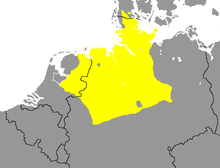West Low German
This article needs additional citations for verification. (December 2009) |
| West Low German | |
|---|---|
| German: Westniederdeutsch | |
| Native to | Germany, Netherlands, Southern Denmark |
Indo-European
| |
| Language codes | |
| ISO 639-2 | nds for Low German |
| ISO 639-3 | Variously:wep – Westphaliannds – (partial)frs – Eastern Frisiangos – Groningsstl – Stellingwerfsdrt – Drentstwd – Twentsact – Achterhoekssdz – Sallandsvel – Veluws |
| Glottolog | west2357 |
 West Low German area in yellow. This area is also called Low Saxon. | |
West Low German, also known as Low Saxon (German: Westniederdeutsch, literally West Low German, or Niedersächsisch (in a stricter sense), literally: Low Saxon, Nether-Saxon; Low German: Nedersassisch, Nedersaksies; Dutch: Nedersaksisch) is a group of Low German (also Low Saxon; German: Plattdeutsch, Niederdeutsch, Dutch: Nederduits) dialects spoken in parts of the Netherlands, northwestern Germany and southern Denmark (in North Schleswig by the German minority). It is one of two groups of mutually intelligible dialects, the other being East Low German dialects. A 2005 study found that there were approximately 1.8 million "daily speakers" of Low Saxon in the Netherlands. 53% spoke Low Saxon or Low Saxon and Dutch at home and 71% could speak it.[1] According to another study the percentage of speakers among parents dropped from 34% in 1995 to 15% in 2011. The percentage of speakers among their children dropped from 8% to 2% in the same period.[2]
Extent[]
The language area comprises the North German states of Lower Saxony, North Rhine-Westphalia (the Westphalian part), Bremen, Hamburg, Schleswig-Holstein and Saxony-Anhalt (the northwestern areas around Magdeburg) as well as the northeast of The Netherlands (i.e. Dutch Low Saxon, spoken in Groningen, Drenthe, Overijssel and northern Gelderland) and the Schleswigsch dialect spoken by the North Schleswig Germans in the southernmost part of Denmark.
In the south the Benrath line and Uerdingen line isoglosses form the border with the area, where West Central German variants of High German are spoken.
List of dialects[]
Germany[]
- West Low German
- Westphalian, including the region around Münster and the Osnabrück region of Lower Saxony
- Eastphalian, spoken in southeastern Lower Saxony (Hanover, Braunschweig, Göttingen) and in the Magdeburg Börde region
- Northern Low Saxon

Netherlands[]
While Dutch is a Low Franconian language, the Dutch Low Saxon varieties, which the Dutch government considers to be Dutch dialects, form a dialect continuum with the Westphalian language. They consist of:
- West Low German
- Westphalian
- Stellingwarfs in southeastern Friesland
- Midden-Drents
- Zuud-Drèents
- Tweants and Tweants-Groafschops in the Twente region of Overijssel and the adjacent Achterhoek region of Gelderland
- Veluws in the Veluwe region of Gelderland
-
- Achterhooks
- Sallaans in the Salland region of western Overijssel
- Urkers on the former island of Urk in Flevoland
- Northern Low Saxon
- , in western Groningen
- Gronings, in Groningen and northern Drenthe, by its Frisian substratum related to Friso-Saxon dialects
- Westphalian
Denmark[]
- West Low German
- Northern Low Saxon
- Schleswigsch dialect spoken in former South Jutland County (the northern part of the former Duchy of Schleswig) around Aabenraa (Apenrade)
- Northern Low Saxon
References[]
- ^ [Bloemhoff, H. (2005). Taaltelling Nedersaksisch. Een enquête naar het gebruik en de beheersing van het Nedersaksisch in Nederland. Groningen: Sasland.]
- ^ Driessen, Geert (2012). "Ontwikkelingen in het gebruik van Fries, streektalen en dialecten in de periode 1995-2011" (PDF). Radboud University Nijmegen. Retrieved 2017-04-29.
- ^ Jump up to: a b c d e f g Noble, Cecil A. M. (1983). Modern German dialects. New York [u.a.], Lang, p. 103-104
- Culture of Lower Saxony
- Dutch dialects
- German dialects
- Low German